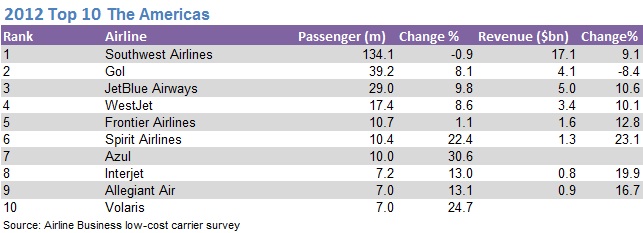Airline consolidations may have helped re-invigorate major US network carriers, but the profitability of the nation's low-cost operators could mean they can continue to thrive without merging operations.
While Southwest Airlines' move to acquire AirTran Airways nearly three years ago marked the biggest merger in low-cost carrier history, industry analysts suggest the US budget sector's financial performance may mean there is little impetus for further deals.
"When airlines are successful, there is no need to merge or acquire," says Mike Miller, president of Miller Air Group. "Allegiant, Spirit and JetBlue are all in that category. They have the ability to chart their own course because the path they have set is successful."
That does not mean low-cost mergers are unimaginable. Some analysts see synergies between JetBlue, Spirit Airlines, Frontier Airlines and Allegiant Air, all of which operate Airbus A320 family aircraft.
But differences among brands, strategies, operations and computer systems raise doubts about whether consolidation benefits would outweigh costs, says Michael Boyd, chairman of aviation consulting firm Boyd Group International. "There are a lot of costs in putting airlines together, and sometimes it might exceed the value," he says.
JetBlue chief Dave Barger implies his airline is not looking to merge. JetBlue is "committed to growing with our own aircraft and our own people", he recently told investors. Analysts do not expect Southwest to participate in any mergers until it finishes digesting AirTran. And they say the financial and operational performance of JetBlue, Spirit and Allegiant indicates healthy standalone carriers. The carriers posted combined net profits of $682 million in 2012.
 |
|---|
Republic Airways subsidiary Frontier and privately-held Virgin America, however, have over the years found profits more elusive.
"Virgin America needs to make money or it can't survive. They don't need to grow, they need to make money," says Miller.
Virgin America chief executive David Cush acknowledges that Virgin needs to show profitability soon.
"If airlines are not profitable and they can't show a path to profitability and a track record of profitability, then capital will dry up," he tells Flightglobal. But Cush says the six-year-old airline, which has never reported a full-year of profits and posted an operating loss of $31.7 million for 2012, will soon be in the black.
Virgin America recently emerged from a period of rapid growth, and will now let markets mature, Cush says. The airline added 27% capacity in 2012, but will grow in the "low single digits" in 2013, Cush says.
In addition, Virgin America recently restructured debt and received $75 million in new financing.
"We will make money in 2013. We will make a healthy amount of money," he predicts.
Frontier did turn around losses to post a profit at an operating level in 2012, but made a loss of $20 million in the first quarter of 2013, when capacity shrank 6% year on year.
Republic hopes to sell Frontier by this summer, but continues to transform the airline into an ultra low-cost carrier. Frontier will start charging some customers a fee for carry-on baggage and soft drinks this summer.
Differences between US low-cost airlines make the term "low-cost carrier" obsolete, say analysts. Vaughn Cordle, an airline analyst at Ionosphere Capital, calls JetBlue a "hybrid" airline with relatively low costs but good service, which attracts business customers.
Boyd suggests the only true low-cost carrier is Spirit, which employs the traditional strategy of using discounts to generate new customer demand - evidenced in Dallas, Detroit, Denver and Houston where Spirit is expanding. Spirit reported a cost per available seat mile (CASM) of 10.09 cents for 2012. Although Allegiant's CASM was comparable at 10.37 cents, it operates more like a "charter airline with a schedule", suggests Boyd.
Regardless of definition, low-fare carriers must keep costs down. Boyd notes that Southwest, once the undisputed low-cost king, has seen costs climb in recent years. Southwest's 2012 CASM was 12.85 cents, just a few cents lower than network carriers' 13-15 cents.
"Southweste_SLps needs to start doing things they haven't done in the past," says Cordle, referring to Southwest's decision to charge for early check in and priority boarding.
Low-cost carriers must also combat fierce competition from network carriers, which have been strengthened through consolidation. United Airlines, Delta Air Lines and a merged American Airlines-US Airways can use their vast resources to drive off newcomers by flooding routes with capacity, says Cordle.
By summer United will have more than doubled flights between Newark and San Francisco and Los Angeles, a move that follows Virgin's launch of services on those routes. "They can take losses in any given market that would not be bearable if United was two-thirds smaller," Cordle says.
Network carriers have also strengthened ties with business travellers by rewarding frequent customers with preferred seating and free benefits. "When price isn't materially different, the perks make more sense," says Boyd.
But mega mergers may also create opportunities for low-cost airlines.
Before 2005, seven network airlines battled each other in what Cordle calls "hard competition". Today's market is different. If US Airways merges with American Airlines, three carriers of comparable size will dominate the industry, resulting in "soft competition." Cordle believes this will see average fares rise. "Hence, we have an opening for low-cost airlines," he says.
Source: Air Transport Intelligence news
















